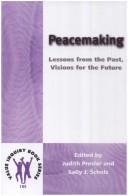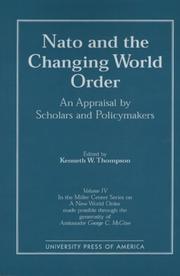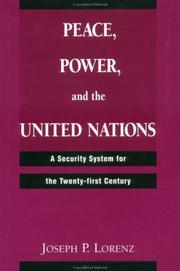| Listing 1 - 10 of 82 | << page >> |
Sort by
|

ISBN: 9789004458628 9789042015623 Year: 2000 Publisher: Leiden; Boston : BRILL
Abstract | Keywords | Export | Availability | Bookmark
 Loading...
Loading...Choose an application
- Reference Manager
- EndNote
- RefWorks (Direct export to RefWorks)
Peacemaking includes a large array of activities from local to global attempts to attain peace. It includes consideration of international, interstate, and intertribal conflict resolution; communal, personal, and interpersonal social justice; deterrence of the use of nuclear weapons; design of international treaties that prevent war or other forms of international conflict; disarmament; international organizations that secure the order among nations; and even, from some points of view, war. As the 20th century drew to a close, we have witnessed peacemakers trying to end ethnic cleansing, reinstate justly elected political leaders, and reach compromises in the ideological differences that perpetuate age-old conflicts. We also see peacemaking in our schools, homes, and workplaces. Philosophers have long been interested in peacemaking in one form or another, and philosophical accounts of peacemaking reflect the variety of perspectives, methods, and activities developed in pursuing peacemaking. In some instances, philosophers expand upon the situations, activities, and methods of the peacemaker in the field. The essays in this volume propose some theoretical arguments for various aspects of peacemaking, offer nonmilitary alternatives to war, and discuss practical examples of peacemaking in daily life. The contributors analyze power relations, language, social groupings, and distribution of resources. At times, they draw insight from social and historical models of conflict and conflict-resolution. This collection of essays on peacemaking aims to enlighten contemporary social and political discussions and contribute to achieving the ever-challenging goal of peace.
Book
ISBN: 900445862X Year: 2000 Publisher: Leiden; Boston : BRILL,
Abstract | Keywords | Export | Availability | Bookmark
 Loading...
Loading...Choose an application
- Reference Manager
- EndNote
- RefWorks (Direct export to RefWorks)
Peacemaking includes a large array of activities from local to global attempts to attain peace. It includes consideration of international, interstate, and intertribal conflict resolution; communal, personal, and interpersonal social justice; deterrence of the use of nuclear weapons; design of international treaties that prevent war or other forms of international conflict; disarmament; international organizations that secure the order among nations; and even, from some points of view, war. As the 20th century drew to a close, we have witnessed peacemakers trying to end ethnic cleansing, reinstate justly elected political leaders, and reach compromises in the ideological differences that perpetuate age-old conflicts. We also see peacemaking in our schools, homes, and workplaces. Philosophers have long been interested in peacemaking in one form or another, and philosophical accounts of peacemaking reflect the variety of perspectives, methods, and activities developed in pursuing peacemaking. In some instances, philosophers expand upon the situations, activities, and methods of the peacemaker in the field. The essays in this volume propose some theoretical arguments for various aspects of peacemaking, offer nonmilitary alternatives to war, and discuss practical examples of peacemaking in daily life. The contributors analyze power relations, language, social groupings, and distribution of resources. At times, they draw insight from social and historical models of conflict and conflict-resolution. This collection of essays on peacemaking aims to enlighten contemporary social and political discussions and contribute to achieving the ever-challenging goal of peace.
Book
ISBN: 2735129225 9782735129225 Year: 2023 Publisher: Paris: Éditions de la Maison des sciences de l'homme,
Abstract | Keywords | Export | Availability | Bookmark
 Loading...
Loading...Choose an application
- Reference Manager
- EndNote
- RefWorks (Direct export to RefWorks)
"Construire" la paix : l'expression fait rêver mais évoque un scénario trop bien connu dans lequel les solutions que prêchent la plupart des politiques - l'intervention des Casques bleus ou le versement de millions de dollars - ne parviennent à résoudre les conflits. Pourtant, des stratégies ont permis de construire une paix durable dans les zones de conflit, en particulier pour les citoyens ordinaires. Quelles sont-elles ? Et pourquoi d'autres citoyens ordinaires, à des milliers de kilomètres de là, devraient-ils eux aussi s'en inspirer ? Séverine Autesserre examine l'industrie de la paix - organisations non gouvernementales, ambassades...- et montre, en s'appuyant sur des cas du monde entier, que la paix peut se développer dans les circonstances les plus improbables, à une simple condition : une paix durable exige de donner le pouvoir aux citoyens locaux. Parfois soutenues par des étrangers, leurs initiatives novatrices montrent qu'un changement d'approche radical est à opérer si nous voulons construire une paix durable autour de nous, en France, au Congo ou ailleurs.
Peace --- Peace-building --- Peaceful change (International relations)

ISBN: 0761802037 Year: 1996 Publisher: Lanham (Md.) : University press of America,
Abstract | Keywords | Export | Availability | Bookmark
 Loading...
Loading...Choose an application
- Reference Manager
- EndNote
- RefWorks (Direct export to RefWorks)
Book
Year: 2001 Publisher: Washington, DC : U.S. Institute of Peace,
Abstract | Keywords | Export | Availability | Bookmark
 Loading...
Loading...Choose an application
- Reference Manager
- EndNote
- RefWorks (Direct export to RefWorks)
Peaceful change (International relations) --- Peace. --- Mediation, International.

ISBN: 0813380618 Year: 1999 Publisher: Oxford Boulder, Col. Westview Press
Abstract | Keywords | Export | Availability | Bookmark
 Loading...
Loading...Choose an application
- Reference Manager
- EndNote
- RefWorks (Direct export to RefWorks)
Book
ISBN: 0333650719 Year: 1996 Publisher: London Macmillan
Abstract | Keywords | Export | Availability | Bookmark
 Loading...
Loading...Choose an application
- Reference Manager
- EndNote
- RefWorks (Direct export to RefWorks)
Book
ISBN: 9783319628578 3319628577 Year: 2018 Publisher: Cham: Palgrave Macmillan,
Abstract | Keywords | Export | Availability | Bookmark
 Loading...
Loading...Choose an application
- Reference Manager
- EndNote
- RefWorks (Direct export to RefWorks)
This book is a critical political and institutional reflection on UN peace operations. It provides constructive suggestions as to how the UN and the international system can evolve to remain relevant and tackle the peace and security challenges of the 21st century, without abandoning the principles that the UN was founded upon and on which the legitimacy of UN peace operations rests. The author analyses the evolving politics on UN peace operations of the five veto powers of the UN Security Council, as well as major troop-contributing countries and western powers. He investigates the move towards peace enforcement and counter-terrorism, and what consequences this development may have for the UN. Karlsrud issues a challenge to practitioners and politicians to make sure that the calls for reform are anchored in a desire to improve the lives of people suffering in conflicts on the ground-and not spurred by intra-organizational turf battles or solely the narrow self-interests of member states. Finally, he asks how the UN can adapt its practices to become more field- and people-centered, in line with its core, primary commitments of protecting and serving people in need. "An excellent resource for researchers, policy-makers, practitioners and students, this work provides a very useful analysis on the past, present and future of peace missions, as well as how they have and could face the challenges of today's world." -Séverine Autesserre, Associate Professor, Barnard College,Columbia University, USA "The international community and the new Secretary-General will have a chance to initiate meaningful, transformative reforms in the way the United Nations addresses social, political and security challenges; the road map is provided by John Karlsrud, highly recommended to all international peace and security academics and practitioners." -José Ramos-Horta, Nobel Peace Prize laureate and former President and Prime Minister of Timor Leste "This is the most current, up-to-date assessment of UN Peace Operations available. A must-read for both analysts and practitioners of peacekeeping." -Lise Morjé Howard, Georgetown University, USA
Book
ISBN: 3666101275 3647101273 Year: 2013 Volume: 94 Publisher: Gottingen : Vandenhoeck & Ruprecht,
Abstract | Keywords | Export | Availability | Bookmark
 Loading...
Loading...Choose an application
- Reference Manager
- EndNote
- RefWorks (Direct export to RefWorks)
Die Verhandlungen um Frieden glichen im Europa der Frühen Neuzeit dem Aushandeln eines Geschäfts, das von Akteuren, spezifischen Umständen aber auch Zufällen beeinflusst wurde. Daher war die Gefahr missverständlicher Übersetzungs- und Deutungsoptionen fester Bestandteil von Friedensverhandlungen. Auch die »Ignoranz« spielte in der Politik und Jurisprudenz der Frühen Neuzeit eine wichtige Rolle. Häufig wurde Unwissen vorgetäuscht, um argumentative, politische und juristische Vorteile zu erlangen. In diesem Band versammeln sich Frühneuzeit-, Ideen-, Friedens-, Rechts- und Kunsthistoriker, um zen
Peaceful change (International relations) --- International relations --- Peace --- World politics
Book
ISBN: 9780367894542 9781032200897 Year: 2022 Publisher: Abingdon, Oxon ; New York, NY : Routledge,
Abstract | Keywords | Export | Availability | Bookmark
 Loading...
Loading...Choose an application
- Reference Manager
- EndNote
- RefWorks (Direct export to RefWorks)
"This book provides a comprehensive and up-to-date picture of territorial change on the municipal level across all European countries. Taking a thematic and comparative perspective, the book builds on extensive quantitative data and a large survey of academic experts in 33 European countries. Territorial organization of the municipal level in Europe is strongly diversified and yet far from stable. Politically speaking, territorial reforms tend to be risky and difficult, as such changes affect vital interests and identities. Despite such difficulties, the last two decades have witnessed considerable changes in territorial divisions at the municipal level across a range of European countries. In this book, the authors describe and analyze these changes comprehensively, making a vital contribution to understanding the reasons and dynamics of territorial reform processes. This book will be of key interest to scholars, students and practitioners in local or sub-national government, institutional design and more broadly to political science, public administration/policy, human geography, sociology and economics"--
| Listing 1 - 10 of 82 | << page >> |
Sort by
|

 Search
Search Feedback
Feedback About UniCat
About UniCat  Help
Help News
News